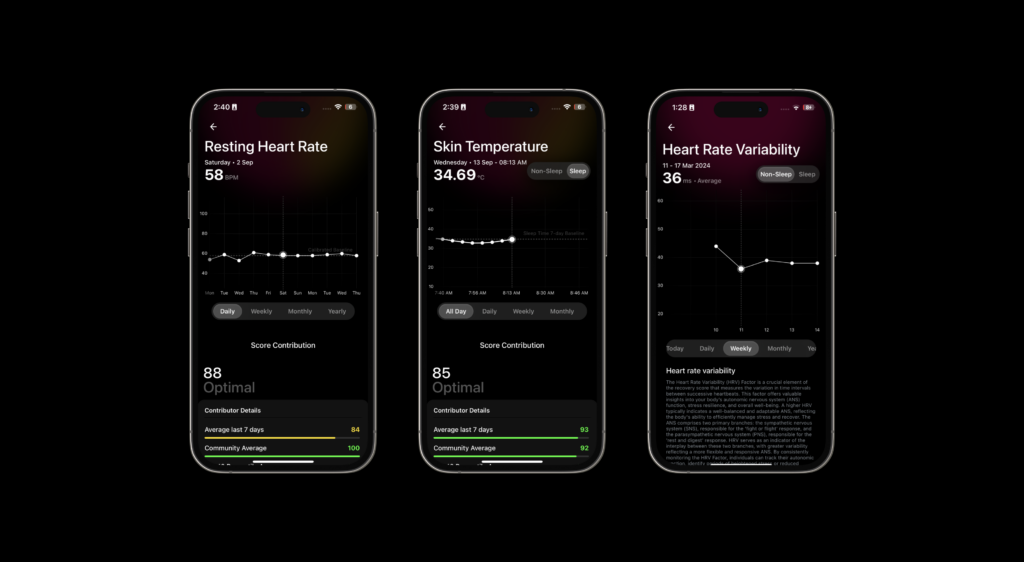The tracking of heart rate variability (the time interval between consecutive heartbeats in milliseconds) provides a great tool for gaining insight into your body and a better understanding of your mental and physical state.
This variation is modulated by the autonomic nervous system (ANS). If the ANS is in a fight-or-flight mode, the HRV tends to be lower, and when it’s generally in the rest and digest mode, the HRV is usually higher.
So, HRV is a reliable, noninvasive marker of the imbalance in the ANS. It is also an efficient indicator of managing workout intensities.
With the help of reliable monitors and devices, tracking your heart rate variability (HRV) is a fairly simple feat. However, more often than not, people tend to make some rookie mistakes or fall prey to some common misconceptions when it comes to measuring HRV and interpreting the results.
What are these mistakes? How can they be avoided? Here’s all you need to know.
Read next: How to increase heart rate variability
Hyperfocusing on daily numbers

Your most recent HRV score can be useful for deciding whether to train hard or as an early-warning system for potential illness, but long-term trends are far more useful. Removing the noise of everyday life and looking over weeks and months can help you to see how your health is changing.
To see trends, you first need to calculate your HRV baseline, which is just your average HRV over a standard week where your life is fairly normal and easy-going. Once you establish a baseline, then you can start comparing that to future readings. Wearables such as the Ultrahuman Ring AIR will do that automatically.
There are two kinds of trends you want to pay attention to: short-term trends and long-term trends. Short-term trends in your HRV will be impacted by factors such as pushing too hard with your workouts, not getting enough sleep, or drinking alcohol.
It’s worth noting that sometimes, short-term trends might not be easily explained. In that case, think of what’s going on in your life that may not be so obvious, but could impact your short-term HRV. Consider things like poor sleep or any recent changes that you’ve made to your lifestyle.
Think of long-term trends as changes from your baseline that go on for more than seven days. However, identifying a long-term trend may not be as simple as spotting an increase or decrease in HRV. For example, a negative long-term trend could be increasing fluctuation in your daily readings or seeing your average HRV fall.
Negative long-term trends typically involve changes in habits or lifestyle that impact you over time. For example:
- A job, a significant life change, or relationship problems that contribute to an increase in stress.
- Long-term poor diet or sleepless periods.
- Underlying health conditions, perhaps paired with increases in metrics such as resting heart rate or poor recovery scores.
On the other hand, positive HRV trends will most likely show you steady increases. Extended healthy habits, increasing fitness, or just finding a happy rhythm in life can show up with increased heart rate variability.
Thinking that a high HRV is always desirable
A high HRV reading doesn’t automatically mean that everything is in order. It can sometimes suggest that something isn’t quite right and should be looked into.
When you get sick and your immune system goes into overdrive, it can boost your HRV to excessive numbers, sometimes referred to as “HRV overshoot“. A heightened immune system is great for helping you feel better, but you shouldn’t look at this increase in HRV as time to go and push hard.
The moral of the story is, as ever, check in with yourself and how you feel. Huge HRV numbers should be viewed with suspicion.
Believe that a low HRV is always a red flag
A single low HRV score isn’t a red flag — in fact, short-term drops can be a sign your body is adapting to stress. Intense workouts, late meals, or psychological stress can all reduce HRV temporarily. But as long as your readings return to baseline, these dips are usually part of a healthy recovery cycle.
Chronically low HRV, however, is more concerning and may indicate poor recovery, illness, or overtraining. If you’re training hard, it’s normal — even desirable — to see HRV drop and rebound. That rebound is a key indicator of adaptation. The goal isn’t to avoid stress altogether, but to recover from it effectively.
Only measuring HRV on workout days

It’s a mistake to only measure your HRV on certain days, like on days you’ve scheduled to exercise or busy days, which you know are going to be very stressful. Being selective about measuring only on particular days won’t give you a complete picture of what’s going on with your HRV.
Consistency is key when it comes to measuring your HRV. If possible, measure HRV at the same time and in the same position (sitting, lying down, etc) every day. That way, you have a clearer picture when it comes to interpreting the results.
That’s where wearables such as the Ultrahuman Ring AIR that track HRV against your baselines, during sleep, can offer good quality, consistent data.
Comparing your HRV with others
HRV varies from person to person. Your HRV is going to be different from your mom’s, sibling’s, or friend’s. Looking at other people’s HRV can’t tell you a whole lot about your own health. For that reason, the only person whose HRV matters is yours.
Instead of comparing yourself to others, take a look at trends within your own HRV. Compare your present and past measurements to gain better insight. HRV can tell you about your current behaviours and what you might need to change to become a healthier individual.
Conclusion
HRV is a good metric to gauge stress and check for imbalances in the autonomic nervous system. It’s easy to make mistakes while measuring HRV, but fortunately, many of these are completely avoidable. Try not to get too hung up on absolute readings with your HRV. Instead, focus on short and long-term trends to see how your HRV changes over time.
Keep in mind that a high HRV doesn’t always mean everything is in order, just like a low HRV isn’t always a cause for concern. Be consistent with measuring your HRV (i.e. even measuring on “non-important” days) and try your best not to compare yourself with others. Your own HRV is the only one that matters.
Disclaimer: The contents of this article are for general information and educational purposes only. It neither provides any medical advice nor intends to substitute professional medical opinion on the treatment, diagnosis, prevention or alleviation of any disease, disorder or disability. Always consult with your doctor or qualified healthcare professional about your health condition and/or concerns before undertaking a new healthcare regimen including making any dietary or lifestyle changes.
References







